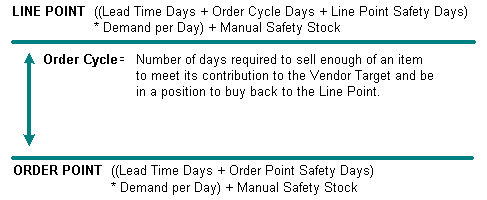
A product's order point indicates the minimum amount of stock you want to have on the shelf for a given item. When an item's projected inventory level (PIL) falls below its order point, the Suggested P/O program suggests that you purchase enough stock to bring all items in the buy line to their adjusted line points. That is, the line point adjusted up or down to meet the vendor target.
The Suggested P/O report can include products that were not below their order points.
A product's order point is the sum of the lead time days plus order point safety days, multiplied by the average demand for the item per day. If you define manual safety stock, this stock is added as a last step in determining the item's order point.

Note: If a minimum amount of quantity to stock is set on the User Inventory Controls screen and the setting has not expired, then that amount overrides the order point calculation. You can set a minimum-only order point for a product to make sure the system uses the largest line point available.
Lead Time Days – The time it takes to replenish a product. You do not want your stock levels to fall below the amount that you can sell during the time it takes the vendor to ship the material to you.
Order Point Safety Days – To ensure against possible out of stock periods, you also want to consider safety days in the order point calculation. Safety days translate into safety stock, which provides a cushion when daily sales exceed the average daily sale quantity.
Demand per Day – Product demand drives the automated purchasing and transfer system. Formulas built into the safety day calculation compensate for the differences between fast-moving, high demand items, and slow-moving, low demand items.
Manual Safety Stock – Also known as service stock, this is a quantity added to the order point to honor a commitment to keep a quantity of stock on the shelf.
When calculating the order point for a baby branch in a parent/baby relationship, the lead time for the baby branch is the greater of the lead time of the parent branch or the transfer cycle from the parent branch to the baby branch. This method protects the baby branch from running out of material during the transfer cycle.
See Also:
Order Points and Line Points Overview
How the System Calculates Line Point Safety Days
How the System Calculates Line Points
How the System Calculates Order Point Safety Days